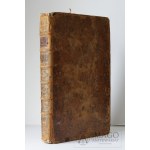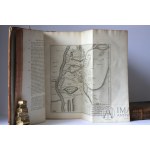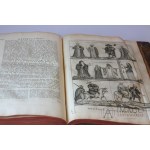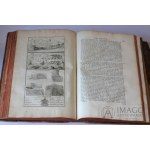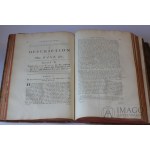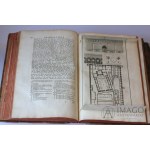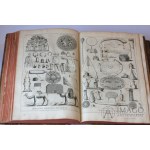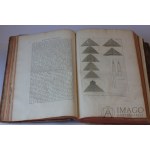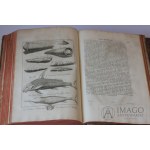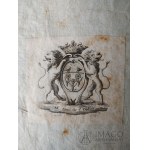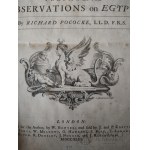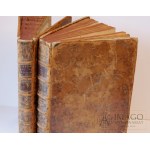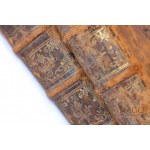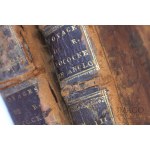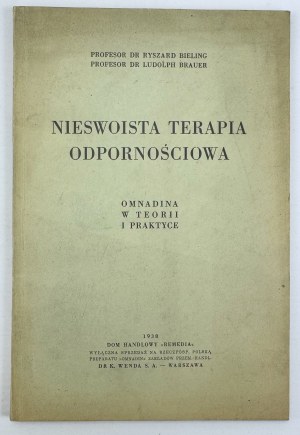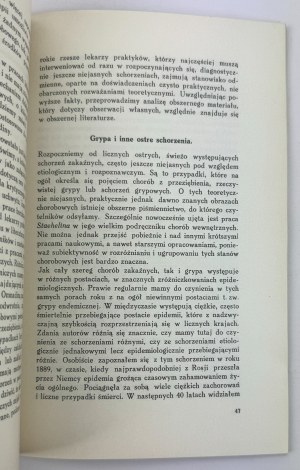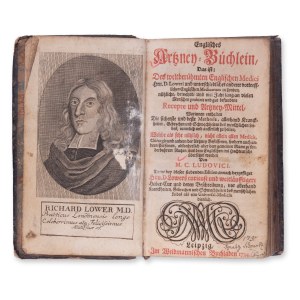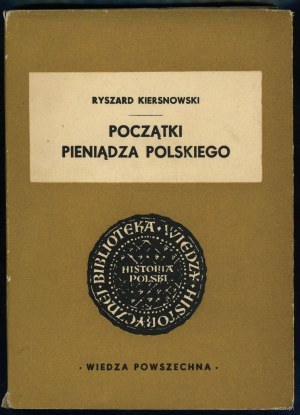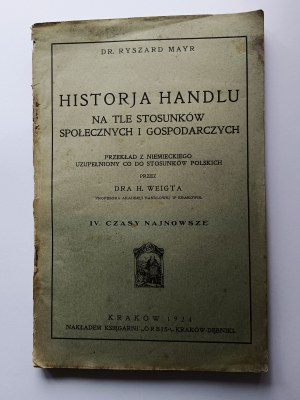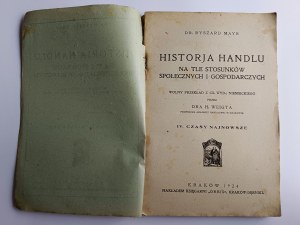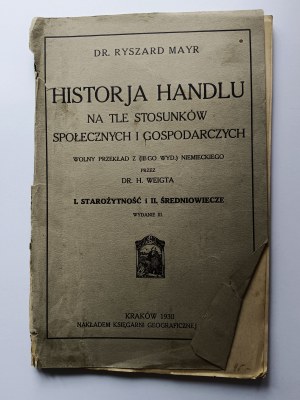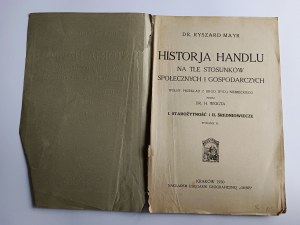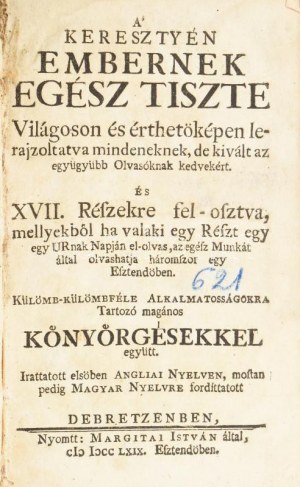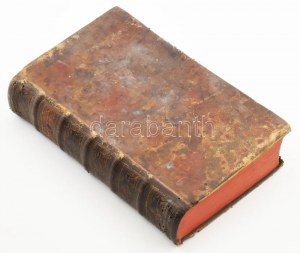POCOCKE, Richard: A Description of the East, and Some other Countries. volume one: Observations on Egypt. London: Printed for the author by W. Bowyer; MDCCXLIII (1743) p. 310, numerous tables and maps, complete, 420x260mm
A rarity in folio format.
old print in English
Mistaken order of sewn-in plates (XXXIV instead of after page 100 is after 104), but they are all there. We detected a printing error in this piece. Printed pages 250 and 251 again instead of pages 254 and 255. otherwise complete. Block in very good condition. Clean.
Exlibris engraved by E. Voysard for Mr. Ame de St. Dider
Alexandre Charles Nicolas Amé de Saint-Didier , born19 March 1778in Versailles , died15 April 1850 rdo Ferreux-Quincey (Aube), one of France's highest officials and politicians. Prefect of the Empire to Napoleon I.
Étienne Claude Voysard (1746-1807) French copperplate engraver. He made many portraits and paintings (including the first portrait of Louis XVI 1774)
Full leather, original period binding. Fair condition.
The Grand Tour was a journey complementing classical education in the second half of the 17th and especially in the 18th century. Young men, most often of the aristocracy, and in the second half of the 18th century simply the eldest sons, wishing to hold high social, political, military or religious positions in the future went on a journey to places that were the source and foundation of our civilization, in order to see, absorb and explore them, to acquire self-reliance and self-control, familiarity and sensitivity to harmony, beauty and aesthetic taste. During these trips they met many interesting people of science, art and politics, with whom they corresponded after returning to their home country. Most often they went to Italy, the Holy Land and Egypt. In this way they got to know the places they had previously learned about, such as Rome, Florence, Padua, Venice, Paris, but also Berlin, Dresden, Vienna and London for travelers from the Continent... They also visited lands known from ancient texts, which they had learned by heart throughout their childhood and youth. Places sunged about by Homer and described by Herodotus, Nestor or others. During their travels, they put into practice the languages they had mastered during their education and, above all, fulfilled their youthful needs to discover, explore, observe, name and describe the world. For the most part, the Grand Tour was an adventure of a lifetime that shaped their later perceptions of reality and social roles. The term Grand Tour first appeared in the 1698 guidebook An Italian Voyage by Richard Lassels, and one of the first to make an educational journey through Europe was Thomas Coryat (1577-1617), who set out on foot in 1608 to travel through Italy. Considered the father of the Grand Tour, he mapped out an itinerary for future travelers, complete with "obligatory stations" in his book Curyat's Creduties. The custom of taking the Grand Tour left its mark on the culture of northern Europe. Memories remained of the journeys, often recorded in book form.
One of the most important authors accurately describing his journey was Richard Pococke (born November 19, 1704 in Southampton, died September 25, 1765 in Tullamore) - an English clergyman, hardened traveler and travel writer. He was bishop of Ossory (1756-65) and Meath (1765), both dioceses of the Church of Ireland. However, he is best known for his travel writings and memoirs.
He published his description of the East and some other countries in 2 volumes, and 3 volumes in folio format. The different parts have the following subtitles:
Part I - Observations on Egypt
Part II - Observations on Palestine or the Holy Land, Syria, Mesopotamia, Cyprus and Candia
Part III - Observations on the islands of the Archipelago, Asia Minor, Thrace, Greece and some other parts of Europe (he also described Poland, you will find information about Pica Polonica and witches in our country)
And they contain, in addition to detailed travel descriptions, a number of full-page copperplate illustrations and maps of the places visited. Most of the plates are unsigned. But a few maps are signed as drawn and engraved by T. Jefferys; botanical plates (Vol. I.pl. 72-75, Vol. II.pl. 82-89) drawn and engraved by G.D. Ehret. Two plates in Volume I (38, 39) are signed as engraved by G. Child. In Volume II, five plates are signed as engraved by Sam Wale, and one (No. 16) is signed as engraved by J. Mynde. The title vignette and dedication vignette in Volume I are signed as designed and engraved by H. Gravelot; those in Volume II, Part I and the title vignette of Part II are signed as drawn by H. Gravelot and engraved by C. Grignion. Several plates have their own dedicatory signatures.
The author dedicates Volume I to Henry Earl Pembroke.
POCOCKE, Richard (1704-1765). Description of the East and some other countries. London: W. Bowyer for the author, 1743-1745 (420 x 260 mm).
"Born in England in 1704, with clergy on both sides of his family, early Egyptologist Richard Pococke began his ecclesiastical career in Waterford under the tutelage of his uncle, Thomas Milles, Bishop of Waterford & Lismore. His first preference was as preceptor of Lismore Cathedral (1725).
At the age of twenty-nine, Pococke embarked on his Grand Tour in 1733 with his younger cousin, Jeremiah Milles, and together they visited the cultural centers of France and Italy, ending with a substantial stay in Rome. Cancelled after only nine months to allow Jeremiah Milles to become preceptor of Waterford Cathedral (1735), the cousins spent the next two years planning a more unusual second Grand Tour that would eventually take Pococke to Egypt and other parts of the Ottoman Empire. They set out in the summer of 1736 and traveled through Central Europe, visiting the lesser-known countries of the Habsburg Empire, but their travels were interrupted a second time, in the fall of 1737, when Jeremiah Milles was persuaded to return to Waterford to care for a bishop who was suffering from gallstones - a condition from which he eventually died. The cousins parted ways in Trenton and Pococke, having obtained an Ottoman passport in Venice, embarked on a ship for Alexandria.
Although he traveled throughout the eastern Mediterranean, spending four years in Egypt, the Holy Land, Lebanon, Syria, the Greek islands, Turkey and mainland Greece, he is best known for the scientific and detailed observations he made about Egypt. These observations were presented in volume one of his richly illustrated book, A Description of the East & some other Countries (1743). Although condemned by two rival eastern travel writers - Dr. Charles Perry (1743) and the Reverend Thomas Shaw (1746) - Pococke's publication was an immediate success, and was followed by a second volume (1745) that described all the other places he visited in the East.
During his far-reaching and intrepid journey to the east, Pococke made two separate trips through Egypt. The first took place in early September 1737, when he sailed from Livorno to Alexandria. After a three-week stay in the capital, where he greatly admired Pompey's Column, he visited Rosetta, then left by boat to travel up the Nile to Greater Cairo. After spending almost a month in that city, where he was intrigued by, among other things, the "Mikias," a device for measuring the height of the Nile, he took a boat to Akhmim, where he spent Christmas at a nearby monastery. He then visited Karnak and Luxor, where he viewed the famous antiquities for a period of four days, before continuing on to Aswan, which he reached in late January 1738. From there he traveled to Adfou, Etna and El Qurna, where he visited the famous tombs of kings, and on his way back to Akhmim he visited Quena, Dardana and Girga. In March, Pococke sailed from the port of Damietta to Jaffa on a pilgrimage boat, and after a ten-month journey through the Holy Land, Lebanon, Syria and Cyprus, he arrived back at this port on Christmas Eve 1738. Two days later he sailed to Cairo, where he remained for three months, during which he visited the pyramids of Giza and Sakkara. At the end of March, he left with a caravan for Mount Sinai, where he stayed through the Easter period, and at the end of April he again visited Cairo, Rosetta and Alexandria. On July 2, he embarked by ship for Crete, thus completing his tour of Egypt.
As one of the more learned grand tourists of his time, Pococke devoted much time and attention to studying all aspects of Egyptian culture. The resulting book (1743) is famous not only for its abundance of architectural drawings, but also for its explanations of ancient and more recent history. He also gave vivid descriptions of contemporary life in Egypt; and it was this aspect of his work that earned him a reputation as a pioneer in anthropology. He was also a serious collector, and during his travels in Egypt he collected an interesting assortment of coins, medals, antiquities (including two human mummies and a couple of block statues) and natural curiosities. These were sent back to his mother in England for his cabinet of curiosities and, as far as we know, were kept together throughout his life and were dispersed after his death.
Pococke spent much of his time in the major cities (Alexandria, Rosetta and Cairo), socializing, receiving foreigners, especially English, French and Dutch consuls and merchants associated with English trading houses. The textile trade, which included these individuals, had an added appeal for Pococke: as evidenced by his portrait in exotic Eastern dress; letters to his mother with frequent descriptions of clothing and drapery; and his establishment in later life of linen weaving mills in Ireland, he had more than a passing interest in textiles and their production.
There are three sources for news of Pococke's travels in Egypt: the aforementioned volume of his account of his travels (1743); an unpublished notebook describing his journey from Livorno to Alexandria (British Library, Add. 22995); and two extensive collections of manuscript letters." Dr. Rachel Finnegan
Another interesting fact:
On his way back north, he met Danish traveler Frederik Norden (1708-1742) by chance. Norden continued south, eventually reaching Derr. Both travelers made careful drawings of the Great Sphinx at Giza, but Pococke used some artistic license and replaced the missing nose of the colossal statue. The publication of this work brought prestige to Pococke, and he subsequently became a founding member of the Egyptian Club.




